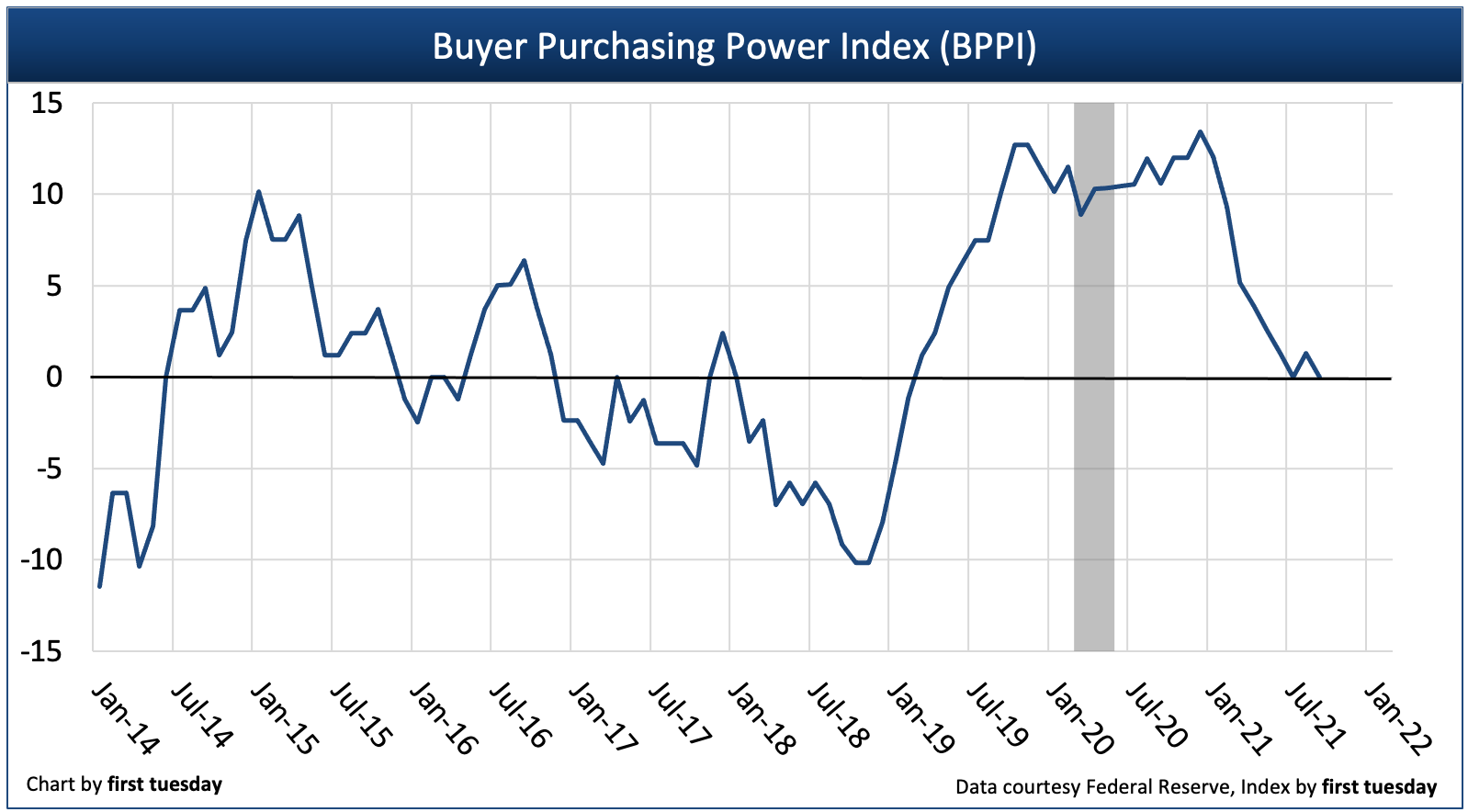The California Buyer Purchasing Power Index (BPPI) figure declined to zero in September 2021. This figure tells us a homebuyer with the same income is able to borrow the same amount of mortgage money as a year ago when mortgage interest rates were roughly level with today’s rates. While not yet negative, Q3 2021’s neutral BPPI figure reflects a worsening situation for homebuyers reliant on mortgage financing, as the BPPI had previously been in the positive due to consistently lower mortgage interest rates since 2019. Going forward, the BPPI will decline as interest rates inevitably rise.

Chart update 10/01/21
| Q3 2021 | Q2 2021 | Q3 2020 | |
| Buyer Purchasing Power Index (BPPI) | 0.0 | +1.3 | +10.6 |
As the BPPI declines, so goes support for home prices. In today’s rising mortgage interest rate environment, both the BPPI and homebuyer participation in the home sales market are adversely affected.
As of July 2021, average California home prices are 21%-to-24% higher than one year earlier. Looking forward, mortgage rate increases will interfere with today’s momentum from rising home prices. Since homebuyers qualify for a maximum mortgage amount based on their incomes, any rise in mortgage rates instantly cuts the amount they can borrow. Thus, the price they pay for a home is reduced.
Thus, lacking the support of falling interest rates, additional stimulus or income boosts, home prices are expected to fall back heading into 2022. Home prices will be further checked by the additional inventory anticipated to arrive in Q4 2021 following the expiration of the foreclosure moratorium.
Related page:
For some background, interest rates descended to historic lows in 2020 due to efforts to stimulate lending despite job losses and tightening access to credit. Beginning in Q1 2020, the Federal Reserve (the Fed) dropped their benchmark interest rate to zero and began purchasing mortgage-backed bonds (MBBs), fulfilling their role as the lender of last resort to ensure mortgage originations continued. The Fed intends to keep this rate at zero until at least 2023, thus interest rates won’t rise significantly until 2023 or later. However, interest rates will still inch higher as the Fed begins their bond taper, gradually decreasing their MBB purchases and allowing rates to rise. In anticipation of this bond taper, investor activity has already begun to push rates higher at the end of Q3 2021.
firsttuesday expects mortgage interest rates to increase slightly in the months ahead, causing the BPPI figure to turn negative in Q4 2021, a year after mortgage interest rates hit historic lows in Q4 2020.
The long-term outlook for the BPPI is a decades’ long period of descent as mortgage rates continue to rise with the economic recovery, likely to gain strength around 2024. Thus, sellers can expect downward pressure on home prices. Without the support of a full jobs recovery, home prices will remain tenuous in 2022.
About the BPPI
The Buyer Purchasing Power Index (BPPI) is calculated using the average 30-year fixed rate mortgage (FRM) rate from Freddie Mac (Western region) and the median income in California.
A positive index number means buyers can borrow more money this year than one year earlier.
A negative index figure translates to a reduced amount of mortgage funds available.
An index of zero means there was no year-over-year change in the amount a buyer can borrow with the same income. At a BPPI of zero, homebuyers cannot purchase at higher prices than one year before unless they resort to adjustable rate mortgages (ARMs) to extend their borrowing reach or greater down payment amounts.
As long-term BPPI trend declines, the capacity of buyers to borrow purchase-assist funds is reduced. In turn, buyers needing purchase-assist financing on average can only pay a lesser price for a home. To keep the inventory of homes for sale moving at the same pace, sellers will need to lower prices to accommodate buyer purchasing power or pull their properties off the market.
—
first tuesday journal online is a real estate news source. It provides analyses and forecasts for the California real estate market, and has done so since 1978.














